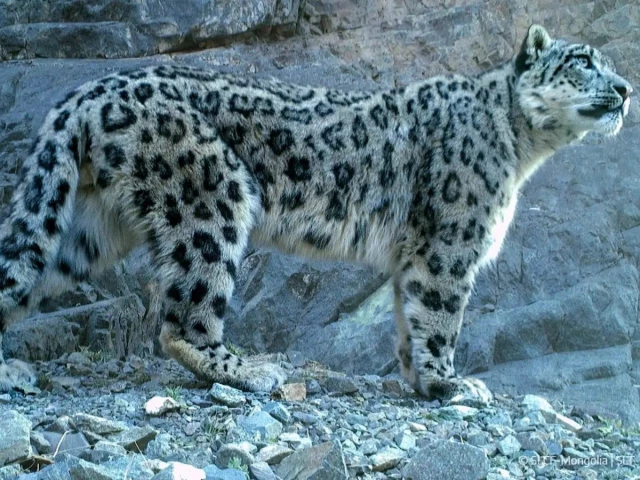As the world marked International Snow Leopard Day on Thursday, Pakistan reaffirmed Pakistan’s commitment to protecting the endangered snow leopard and the fragile high-altitude ecosystems that sustain it.
“Together with mountain communities, scientists and conservation partners, Pakistan is committed to ensuring that the snow leopard continues to thrive as a symbol of resilience and ecological balance in our high mountains,” said Spokesperson for Climate Change and Environment Coordination Saleem Shaikh, underscoring the government’s determination to protect and conserve all mountain species.
Globally, the snow leopard population is estimated at between 3,500 and 7,000 individuals in 12 countries in Central and South Asia, including Afghanistan, Bhutan, China, India, Kazakhstan, Kyrgyzstan, Mongolia, Nepal, Pakistan, Russia, Tajikistan and Uzbekistan. Given the species’ transboundary distribution, regional cooperation is essential for its long-term survival, particularly through data sharing, joint research and coordinated efforts to curb poaching and other anthropogenic threats.
Observed annually on October 23, the theme of International Snow Leopard Day this year is, “Securing Snow Leopard Habitats for Future Generations”, to raise awareness of the endangered species. It is an opportunity for governments and conservationists to encourage local communities to take collective action for Snow Leopards’ protection.
Read: Rare sighting of 4 snow leopards
With an estimated population of 155 to 167 Snow Leopards according to the latest national survey, Pakistan is an active member of the Global Snow Leopard and Ecosystem Protection Program (GSLEP), under which all 12 countries are united in efforts to secure Snow Leopard habitats and promote sustainable development in the high mountains of Asia.
Here, Snow Leopards are spread over 80,000 square kilometers across the Hindu Kush, Pamir, Karakoram and Himalayan mountain ranges of Gilgit-Baltistan and Khyber-Pakhtunkhwa. Mostly found in Chitral, northern KP and GB, they face increasing threats from both climate change and human activities.
The recent survey by the Snow Leopard Trust and Snow Leopard Foundation Pakistan established the first reliable population baseline for the elusive mountain cat, with estimates ranging from 155 to 167 along the country’s alpine terrain.
From 2010 to 2023, wildlife teams and scientists deployed 828 motion-sensing cameras across about 39 percent of the snow leopard’s range in northern Pakistan. The cameras, located in remote valleys, steep ridges and extreme altitudes where Snow Leopards thrive, produced over 4,700 images. The images were collected from 65 locations and identified 53 individuals. Using spatial capture–recapture modeling, the conservation teams estimated a population of about 155 individuals, averaging 0.16 animals per year. 100 square kilometers.
At the same time, from 2017 to 2023, the team collected more than 1,000 suspected Snow Leopard scats along high-elevation transects. DNA testing confirmed that 235 of these belonged to Snow Leopards, and a SNP genetic panel revealed 56 unique individuals. The genetic dataset suggested a population estimate of 167 animals with a 95% confidence interval between 128 and 220.
Read more: WWF warns that infrastructure development threatens the existence of snow leopards
That both camera-based and genetic methods, completely independent and using different data, produced similar estimates strengthens confidence in the results.
Pakistan has a unique place for the species. Its northern mountain ranges, the Hindu Kush, Pamir, Karakoram and Himalayas, converge to form one of the most challenging habitats on Earth. Until recently, estimates of the country’s snow leopard population ranged widely, from 200 to 420, largely guesswork due to the animal’s elusive habits and harsh terrain. Even in stronghold areas such as the Karakoram-Pamir region, densities remain low and the animals face increasing risks, melting glaciers, fragmenting snow, fragmenting human-livestock conflicts and declining prey populations.
“Warming temperatures, retreating glaciers and changing vegetation patterns are steadily shrinking the species’ alpine habitat,” Shaikh said. Apart from that, “overgrazing, depletion of prey species such as ibex and markhor, illegal hunting and retaliatory killings continue to undermine conservation efforts,” he added.
Infrastructure expansion, mining and unregulated tourism in fragile mountain ecosystems have further fragmented the Snow Leopard’s range, according to Shaikh. “Climate-induced habitat shifts are now forcing these cats closer to human settlements, increasing the risk of conflict and poaching.”
Read also: Trail 5 hike to raise snow leopard awareness
The estimated Snow Leopard population numbers, based on advanced camera trap monitoring and field data, provide a robust baseline for developing targeted conservation plans, according to Dr. Nawaz, who led Pakistan’s research team when the study was conducted in collaboration with the Snow Leopard Trust.
“Ensuring effective enforcement of laws on wildlife protection, responsible and environmentally sustainable tourism and climate resilient development in high altitude areas must remain a national priority,” Shaikh said.
Similarly, the Minister for Climate Change and Environmental Coordination Dr. Shezra Mansab Kharal that protecting the snow leopard means protecting the mountains themselves and the people, wildlife and water resources that depend on them.
Important conservation actions ahead include strengthening protected habitats, involving local communities and promoting regional cooperation across the high mountains.
However, field intervention is not enough, believes the climate ministry’s spokesperson. “Awareness and advocacy campaigns in mountain communities can reduce retaliatory killings and promote coexistence through livestock insurance schemes, predator-proof enclosures and community-based ecotourism.”
The Climate Ministry has carried out information campaigns aimed at youth engagement, sustainable tourism and anti-poaching.
Outlining other ongoing initiatives, Shaikh said the climate ministry is implementing several projects such as the Snow Leopard and Ecosystem Protection Program in line with the GSLEP commitments. In addition, the ministry is strengthening community-based conservation in GB and Chitral in collaboration with local and international organizations. These projects provide compensation and alternative livelihoods to herders to address the human threats to Snow Leopards and support their long-term survival.
“These programs have already begun to yield positive results by reducing human-wildlife conflict and improving monitoring capacity in key habitats,” Shaikh asserted, insisting that policy change and public awareness must go hand in hand. “Conservation success depends on both effective governance and community ownership.”
With fewer than 200 individuals estimated nationwide, Pakistan’s snow leopard population is alarmingly small, but for the first time it is clearly understood, laying the groundwork for long-term protection and monitoring.



